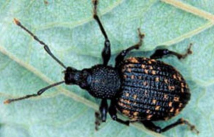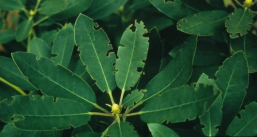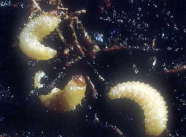HOST PLANTS:
Azalea, Rhododendron, Euonymus, Arborvitae, Hemlock and Yew. ![]()
DAMAGE:
Black vine weevil larvae cause serious injury by eating fibrous roots or stripping the bark off larger roots. Foliage of plants injured by weevil larvae may turn brown or die suddenly. Infested plants grow slowly or fail to grow. They look dry and off-colour. Transplants often die without becoming established. Adults cut crescent-shaped notches in needle margins at night.
DESCRIPTION AND LIFESTYLE:
These black snout beetles overwinter in the soil as early instar grubs or as adults. Look for overwintering larvae to emerge as adults as Hydrangea arborescens ‘Grandiflora’ or ‘Annebelle’ are blooming. Adult weevils (all female) lay eggs for extended periods during the summer. Adult weevils are active at night but can be detected during the day by laying down boards or using pitfall traps. Adults hide in the soil litter during the day. The beetles have fused wing covers and cannot fly.
CONTROL MEASURES:
Larvae control is difficult. Entomopathogenic nematodes are available to help suppress populations of larvae. Nematodes work very well in infested containers but with less success in the field. Nematodes can be applied in late summer/early autumn and in mid-Spring to suppress larval populations.
To monitor for adults, wrap a sheet of burlap around infested plant bases. Adult weevils will hide in the burlap during the day. Place a white sheet under the plant and shake vigorously to dislodge any adults. To control adults, treat foliage, trunk bark and branches during the last week of June and in early July. Spray in the evening, as adult activity increases about an hour after sunset.



REFERENCE: Publication 383 OMAFRA, Pockety IPM Scouting Guide for Woody Landscape Plants Diane Brown-Rytlewski
